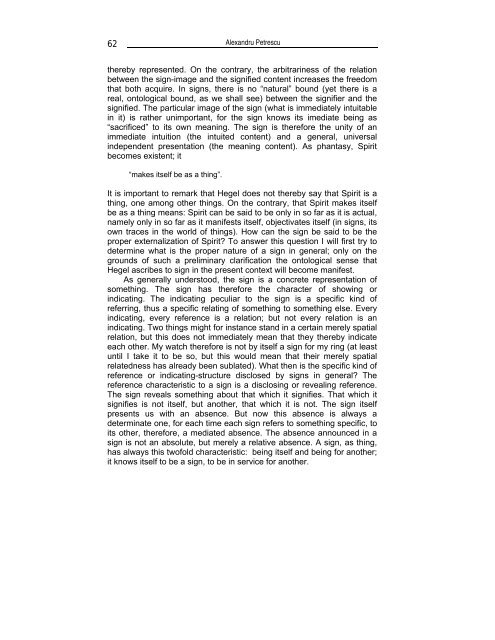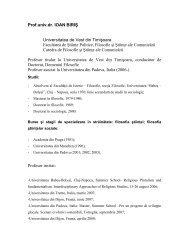analele universităţii de vest din timişoara annales universitatis ...
analele universităţii de vest din timişoara annales universitatis ...
analele universităţii de vest din timişoara annales universitatis ...
Create successful ePaper yourself
Turn your PDF publications into a flip-book with our unique Google optimized e-Paper software.
62<br />
Alexandru Petrescu<br />
thereby represented. On the contrary, the arbitrariness of the relation<br />
between the sign-image and the signified content increases the freedom<br />
that both acquire. In signs, there is no “natural” bound (yet there is a<br />
real, ontological bound, as we shall see) between the signifier and the<br />
signified. The particular image of the sign (what is immediately intuitable<br />
in it) is rather unimportant, for the sign knows its imediate being as<br />
“sacrificed” to its own meaning. The sign is therefore the unity of an<br />
immediate intuition (the intuited content) and a general, universal<br />
in<strong>de</strong>pen<strong>de</strong>nt presentation (the meaning content). As phantasy, Spirit<br />
becomes existent; it<br />
“makes itself be as a thing”.<br />
It is important to remark that Hegel does not thereby say that Spirit is a<br />
thing, one among other things. On the contrary, that Spirit makes itself<br />
be as a thing means: Spirit can be said to be only in so far as it is actual,<br />
namely only in so far as it manifests itself, objectivates itself (in signs, its<br />
own traces in the world of things). How can the sign be said to be the<br />
proper externalization of Spirit? To answer this question I will first try to<br />
<strong>de</strong>termine what is the proper nature of a sign in general; only on the<br />
grounds of such a preliminary clarification the ontological sense that<br />
Hegel ascribes to sign in the present context will become manifest.<br />
As generally un<strong>de</strong>rstood, the sign is a concrete representation of<br />
something. The sign has therefore the character of showing or<br />
indicating. The indicating peculiar to the sign is a specific kind of<br />
referring, thus a specific relating of something to something else. Every<br />
indicating, every reference is a relation; but not every relation is an<br />
indicating. Two things might for instance stand in a certain merely spatial<br />
relation, but this does not immediately mean that they thereby indicate<br />
each other. My watch therefore is not by itself a sign for my ring (at least<br />
until I take it to be so, but this would mean that their merely spatial<br />
relatedness has already been sublated). What then is the specific kind of<br />
reference or indicating-structure disclosed by signs in general? The<br />
reference characteristic to a sign is a disclosing or revealing reference.<br />
The sign reveals something about that which it signifies. That which it<br />
signifies is not itself, but another, that which it is not. The sign itself<br />
presents us with an absence. But now this absence is always a<br />
<strong>de</strong>terminate one, for each time each sign refers to something specific, to<br />
its other, therefore, a mediated absence. The absence announced in a<br />
sign is not an absolute, but merely a relative absence. A sign, as thing,<br />
has always this twofold characteristic: being itself and being for another;<br />
it knows itself to be a sign, to be in service for another.




